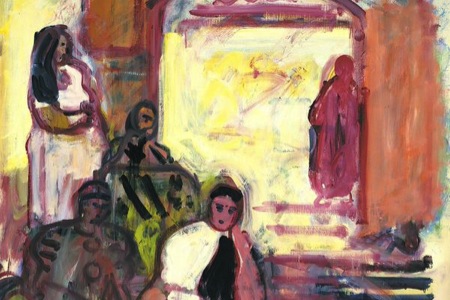Catching Up With Perri Peltz, Director of Remembering the Artist: Robert De Niro, Sr.
Perhaps before anything else, Perri Peltz is a storyteller. Whether she’s donning the hat of a journalist, a radio show host, or a documentarian she’s interested in telling the stories that come to her. Seemingly without ego and without a certain sensationalism that we’ve all come to expect from news stories and—yes—even documentary films, she presents compelling narratives like the one we experienced in Remembering the Artist: Robert De Niro, Sr.. That she was able to capture the attention of the subject’s son, the great Robert De Niro, is impressive. That he went on to entrust her with what was initially meant to be a personal project for his family speaks volumes about her talent and integrity.
We can’t help but be thrilled that De Niro ultimately decided to share this intimate and powerful documentary short with the rest of the world. Remembering the Artist premieres tonight on HBO, and the film will give us a rare glimpse into the lives of two great artists—a father and son who have both left their marks on the world in very unique ways. Paste caught up with Perri Peltz to talk about this exciting project, art history, and her recent experience as a college dropout.
Paste: First of all, I was just blown away by how much you managed to work into a thirty-minute piece.
Perri Peltz: Thirty-nine, but who’s counting? (laughs)
Paste: It was fantastic. Now, I’d read that you went to medical school, but you work in media and film, so I was wondering if you could talk a little about that journey.
Peltz: Well there was about twenty years in journalism work before medical school.
Paste: Ah yes, I see.
Peltz: For a very long time since I got out of college, I was working in television news. I’d worked in local news at WNBC, and then went to NBC network, and then to ABC. And then I did something else and wound up coming back. But I’d always dreamed of going to medical school. So about six years ago, I decided that I would try to make that happen. I was fortunate enough to have the opportunity, but after a year it just proved to be too difficult with my young children, so I decided to drop out—which I thought sounded pretty youthful (laughs).
I then decided that what I wanted to do was to try and and combine journalism with public health issues. I wound up getting involved in documentaries, and doing a film about two women with breast cancer—one with health insurance and one without [The Education of Dee Dee Ricks]. Because, really, my interest in medicine was an interest in public health. That’s how I wound up in documentary!
Paste: You and De Niro have a mutual friend in Jane Rosenthal. What was your reaction when she first approached you with this idea for a film? It was initially supposed to be a documentary for the family, right?
Peltz: Jane is absolutely one of my closest friends in the world, and we have done several projects together over the last twenty years. I’ve had the opportunity to interview Robert De Niro several times when I was in news. So there was some familiarity there. I think that Jane felt that I was somebody who De Niro would be comfortable with. And—to your point—this was not something that was supposed to be broadcast. Bob wanted to do something for the family, for the family archives, but the process just really grew. When you start doing something like this, you think you’re going to be doing it about one person. But, in fact, Robert De Niro, Sr.’s story is bigger than that. It’s not only about figurative painters at a very difficult time in American art history, but it’s also a father/son story, which makes it this universal experience on some level. It’s also a story about the meaning of fame. So when we got to the point where we realized it was bigger, he decided that he was going to allow this to be broadcast. And, very happily, HBO decided that they wanted to get involved.
Paste: Yes, that’s one of the things that I really appreciated about the project— that it’s such a personal story in addition to being an informative piece about the art world. Were there any questions that De Niro wanted to leave unanswered? Was it difficult to get him to open up about certain things?
Peltz: Robert De Niro is an intensely private man. Intensely private, especially given that he is someone who is well within the public arena. But even outside of that he’s very private. It took several interviews for him to really start to open up about his father, and these very personal issues. As you can see from the film this is still a very emotional relationship for him. And so it was difficult—no one wants to interview someone to make them upset.
At the end of the day, I think he’s happy with what came out of this. And I also think that Robert De Niro, Sr. would have been really happy with it, too. I may be presumptuous, but I think he would have liked it. Bob always really wanted people to see the art. It doesn’t mean you have to like it, but he wanted to at least share it.
-

-

-

-

-

-

-

-

-

-

-

-

-

-

-

-

-

-

-

-

-

-

-

-

-

-

-

-

-

-

-

-

-

-

-

-

-

-

-

-









































